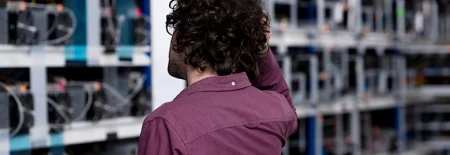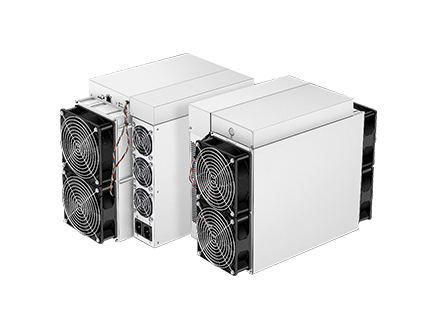I. Introduction
In the ever-evolving landscape of cryptocurrency, Bitcoin remains a dominant force, continually shaping the digital economy. Recently, a notable trend has emerged: a significant rise in Bitcoin transaction fees. While this increase may seem like a drawback for some users, it heralds a golden opportunity for a specific group – the owners of Bitcoin mining machines. This surge in fees is not just a transient phenomenon but a pivotal moment that underscores the evolving dynamics of Bitcoin mining and its profitability.
In this comprehensive exploration, we delve into the intricacies of Bitcoin fees and unveil why this trend is a boon for those invested in the mining infrastructure. We’ll dissect the mechanics behind Bitcoin fees, their impact on the mining landscape, and how high fees are reshaping the future of Bitcoin mining, offering a silver lining for mining machine owners amidst the complexities of the cryptocurrency world.

II. Understanding Bitcoin Fees
At the heart of the Bitcoin network lies a critical component: transaction fees. These fees are not merely incidental charges but play a pivotal role in the ecosystem’s functionality and security. Bitcoin fees are payments made by users to miners, the individuals and companies who use their computational power to process and validate transactions on the blockchain. These fees serve as an incentive for miners, compensating them for the electricity and resources expended in maintaining the network’s integrity.
The mechanics of Bitcoin fees are straightforward yet deeply rooted in the network’s design. Each transaction on the Bitcoin blockchain incurs a fee, determined by the transaction’s data size and the prevailing network conditions. Miners prioritize transactions with higher fees, as these are more lucrative. Consequently, during periods of heightened network activity, when the demand for transaction processing increases, fees tend to rise. This surge in fees can be attributed to several factors, including market rallies, increased adoption, and significant blockchain events like halvings, which reduce the block reward for miners.
Understanding Bitcoin fees requires a grasp of their dual function: they are both a reward mechanism for miners and a regulatory tool for the network. By incentivizing miners, fees ensure that the blockchain remains secure and transactions are processed efficiently. Simultaneously, they help regulate the flow of transactions, preventing spam and ensuring that the blockchain is not overwhelmed. In essence, Bitcoin fees are the oil that keeps the engine of this decentralized ledger running smoothly, balancing the needs of users with the sustainability of the network.
III. The Economics of Bitcoin Mining
Bitcoin mining, at its core, is an economic endeavor driven by the potential for profit. This process involves miners using specialized hardware to solve complex cryptographic puzzles, thereby validating transactions and securing the Bitcoin network. The economics of Bitcoin mining are influenced by several key factors, including transaction fees, the cost of mining equipment, and electricity expenses.
The primary revenue for miners comes from two sources: the block reward and transaction fees. The block reward, halved approximately every four years, is a set amount of bitcoins awarded to the miner who successfully adds a new block to the blockchain. However, as these rewards diminish over time due to halving events, transaction fees increasingly become a significant part of a miner’s income. These fees, paid by users to have their transactions included in the blockchain, vary based on network congestion and the size of the transaction.

Mining profitability hinges on the delicate balance between these income sources and the operational costs, primarily electricity and hardware. The cost of mining equipment can be substantial, but it’s an essential investment for efficient mining operations. Electricity costs, on the other hand, can vary widely based on geographic location and are a continuous expense, as mining requires significant computational power and, consequently, energy consumption.
The halving events play a crucial role in the economics of Bitcoin mining. By reducing the block reward, they create a scarcity of new bitcoins, which can drive up the cryptocurrency’s value. However, they also mean that miners must rely more on transaction fees to sustain their operations. This shift places greater emphasis on the efficiency of mining operations and the strategic selection of transactions with higher fees, making the role of transaction fees ever more critical in the mining ecosystem.
IV. Benefits of High Fees for Miners
The rise in Bitcoin transaction fees, often viewed as a challenge for users, actually harbors significant benefits for miners. These benefits are multifaceted, impacting both the immediate profitability and the long-term sustainability of mining operations.
- Increased Revenue:The most direct benefit of higher fees is the increase in revenue for miners. As transaction fees constitute a part of the total reward for mining a block, higher fees directly translate to greater earnings. This is particularly crucial in the context of the halving of block rewards, as miners become more reliant on transaction fees as a source of income.
- Compensation for Rising Operational Costs:Mining is an energy-intensive process, with electricity costs forming a significant portion of operational expenses. High transaction fees can help offset these costs, making mining ventures more financially viable, especially in regions where electricity prices are steep.
- Encouragement for Network Participation:Higher fees can incentivize more participants to engage in mining. This increased participation not only helps secure the network but also promotes a more decentralized mining landscape, which is a fundamental ethos of the Bitcoin network.
- Selective Transaction Processing:With higher fees, miners have the flexibility to prioritize transactions that offer higher rewards. This selective processing can lead to more efficient use of computational resources, as miners focus on transactions that are most beneficial to them.
- Sustaining Mining Post-Halving Events:As Bitcoin experiences its scheduled halving events, reducing the block reward over time, transaction fees become an increasingly important economic incentive. High fees ensure that mining remains profitable even as the block reward diminishes, thereby supporting the long-term security and viability of the Bitcoin network.
- Case Studies of Profitability:There are numerous instances where mining operations have significantly benefited from periods of high transaction fees. These case studies highlight the potential for increased profitability and serve as a testament to the importance of transaction fees in the mining ecosystem.

V. Mining Machine Market Dynamics
The dynamics of the mining machine market are closely intertwined with the fluctuations in Bitcoin transaction fees. These fees significantly influence the demand for mining hardware, shaping the market in several ways:
- Increased Demand for Efficient Mining Hardware: As transaction fees rise, the profitability of mining operations improves, leading to increased demand for mining machines. Miners seek out the most efficient hardware to maximize their earnings, favoring machines with higher hash rates and energy efficiency. This demand surge often leads to a spike in the prices of top-tier mining equipment.
- Innovation and Technological Advancements: The prospect of higher earnings from elevated transaction fees drives innovation in the mining hardware industry. Manufacturers are incentivized to develop more advanced and efficient mining rigs, pushing the boundaries of mining technology. This continuous innovation cycle leads to the production of machines that offer better performance, consume less energy, and provide a higher return on investment.
- Market Fluctuations Based on Bitcoin’s Performance: The mining machine market is sensitive to the overall performance of Bitcoin. Periods of high transaction fees, often accompanying bullish market trends, can lead to a rush in mining machine purchases. Conversely, when fees and Bitcoin’s value decline, the demand for mining hardware can wane, affecting the market prices and availability of these machines.
- Secondary Market Growth: The fluctuating demand also impacts the secondary market for mining machines. During times of lower profitability, miners may sell off older or less efficient equipment, flooding the secondary market. However, when fees are high, even older equipment can become profitable again, reducing supply in the secondary market and potentially increasing the prices of used mining hardware.
- Global Distribution and Accessibility: The profitability of mining, influenced by transaction fees, affects the global distribution of mining operations. Regions with lower electricity costs and favorable regulations may see an influx of new miners when transaction fees are high, leading to increased demand for mining machines in these areas.
- Investment in Mining Infrastructure: High transaction fees can attract new investors to the mining space, leading to the development of new mining farms and the expansion of existing ones. This investment in mining infrastructure further drives the demand for high-quality mining machines.
VI. Long-Term Implications for Mining Machine Owners
The long-term implications of high Bitcoin fees for mining machine owners extend beyond immediate profitability, shaping the future landscape of Bitcoin mining in several key ways:
- Sustained Profitability: High transaction fees, especially in the context of diminishing block rewards, ensure sustained profitability for mining machine owners. As the block reward continues to halve approximately every four years, transaction fees become a more significant portion of a miner’s income, providing a steady revenue stream.
- Encouragement for Long-Term Investment: The prospect of continued high fees makes investing in mining hardware more attractive. Owners are likely to see a better return on investment over time, encouraging both current miners and new entrants to invest in advanced mining equipment.
- Impact on Mining Strategies: High fees may lead mining machine owners to adjust their strategies. This could include focusing on optimizing their operations for efficiency, investing in renewable energy sources to reduce electricity costs, or even relocating to regions with lower energy prices.
- Market Consolidation and Decentralization: The profitability of mining could lead to market consolidation, with larger mining farms dominating. However, this trend might be counterbalanced by the democratization of mining, as individuals and smaller operations find mining more viable due to higher fees.
- Technological Advancements and Upgrades: The long-term profitability of mining incentivizes continuous technological advancements in mining hardware. Mining machine owners will need to stay abreast of these developments and consider regular upgrades to maintain competitiveness.
- Resilience to Market Fluctuations: High transaction fees can provide a buffer for mining machine owners against Bitcoin’s price volatility. Even during market downturns, the profitability from fees can help sustain operations, making mining a more resilient investment.
- Environmental Considerations: As mining becomes more profitable, there’s an increased focus on the environmental impact of Bitcoin mining. This could lead to a greater emphasis on sustainable mining practices and the use of green energy, aligning profitability with environmental responsibility.
VII. Strategies for Maximizing Mining Profits
In the context of high Bitcoin transaction fees, mining machine owners can adopt several strategies to maximize their profits. These strategies focus on optimizing operations, reducing costs, and enhancing overall efficiency:
- Invest in Efficient Mining Hardware:Choose mining machines with high hash rates and energy efficiency. Up-to-date and powerful hardware can process more transactions and solve blocks faster, increasing the chances of earning both block rewards and transaction fees.
- Optimize Mining Operations:Regularly monitor and optimize your mining setup. This includes fine-tuning your machines for peak performance, ensuring they are running the latest firmware, and maintaining them to prevent downtime.
- Utilize Renewable Energy Sources:To reduce electricity costs, consider using renewable energy sources like solar or wind power. This not only cuts down operational costs but also addresses environmental concerns associated with Bitcoin mining.
- Join a Mining Pool:Collaborate with other miners by joining a mining pool. Pools combine computational resources to increase the chances of mining a block and earning rewards, which are then shared among pool members.
- Strategic Transaction Selection:Prioritize transactions with higher fees when possible. This strategy can be more relevant for miners with enough computational power to have a choice in the transactions they process.
- Geographical Relocation:If feasible, relocate your mining operations to regions with lower electricity costs and favorable regulatory environments. This can significantly reduce operational expenses and increase profitability.
- Diversify Mining Activities:Diversify your mining activities across different cryptocurrencies to spread risk. While Bitcoin may be the primary focus, other cryptocurrencies can offer profitable mining opportunities, especially when Bitcoin fees and rewards fluctuate.
- Stay Informed on Market Trends:Keep abreast of market trends and changes in the Bitcoin network. Being informed allows you to make timely decisions that can affect your mining profitability, such as when to scale up operations or cash out rewards.
- Implement Cost-Effective Cooling Solutions:Efficient cooling systems are crucial for maintaining the longevity and performance of mining hardware. Invest in cost-effective cooling solutions to prevent overheating without significantly increasing your energy expenses.
By implementing these strategies, mining machine owners can enhance their chances of maximizing profits, especially in times of high Bitcoin transaction fees. These approaches require a balance of technical know-how, market awareness, and operational efficiency.
VIII. Risks and Challenges
While high Bitcoin fees present opportunities for mining machine owners, they also come with their own set of risks and challenges that need careful consideration and strategic management:
- Market Volatility:Bitcoin’s price is notoriously volatile. Sudden market downturns can affect the profitability of mining, even when transaction fees are high. Miners need to be prepared for these fluctuations and have a strategy to mitigate potential losses.
- Regulatory Risks:The regulatory environment for cryptocurrencies is still evolving. Changes in regulations can have significant impacts on mining operations, including restrictions or additional costs that could affect profitability.
- Technological Obsolescence:The rapid pace of technological advancement in mining hardware means that equipment can quickly become outdated. Miners must continuously invest in newer, more efficient machines to stay competitive, which can be a significant financial burden.
- Energy Costs and Availability:High energy consumption is a major concern in Bitcoin mining. Rising energy costs or changes in energy policy can significantly impact the profitability of mining operations.
- Network Difficulty Increases:As more miners join the network or as existing miners upgrade their equipment, the difficulty of mining Bitcoin increases. This can reduce the chances of earning rewards, making mining less profitable over time.
- Security Risks:Mining operations are potential targets for cyberattacks. Ensuring the security of both the mining hardware and the digital assets earned is crucial. Security breaches can lead to significant financial losses.
- Environmental Concerns:The environmental impact of Bitcoin mining, particularly its high energy consumption, is a growing concern. This could lead to increased regulatory scrutiny and potential restrictions on mining activities.
- Dependence on Transaction Fees:As block rewards diminish, miners’ dependence on transaction fees increases. This can be risky if transaction volumes decrease or if users migrate to other cryptocurrencies or layer 2 solutions, reducing the potential fees available to miners.
- Operational Management:Running a successful mining operation requires effective management, including dealing with hardware maintenance, cooling solutions, and personnel. Operational inefficiencies can erode profitability.
By understanding and strategically addressing these risks and challenges, mining machine owners can better position themselves to capitalize on the opportunities presented by high Bitcoin fees while mitigating potential downsides.
IX. The Future of Bitcoin Mining
As we look towards the future of Bitcoin mining, several key trends and developments are likely to shape its trajectory, especially in the context of high transaction fees:
- Technological Advancements:Continuous innovation in mining technology is expected to persist. Future mining machines will likely be even more energy-efficient and powerful, offering greater hash rates while reducing energy consumption. This evolution could make mining more profitable and environmentally sustainable.
- Increased Focus on Renewable Energy: Environmental concerns and the high cost of electricity will drive miners towards renewable energy sources. The use of solar, wind, and hydroelectric power for mining operations is likely to become more prevalent, aligning profitability with environmental responsibility.
- Decentralization Efforts: While there’s a trend towards the centralization of mining power in large farms, there’s also a growing movement to decentralize mining. This could involve more individuals participating in mining or the development of decentralized mining pools, enhancing the security and resilience of the Bitcoin network.
- Impact of Regulatory Changes: The regulatory landscape for cryptocurrencies, including mining, will continue to evolve. Positive regulations could boost the industry, while restrictive policies might hinder its growth. Miners will need to adapt to these changes and may see shifts in the global distribution of mining operations.
- Integration of Layer 2 Solutions: Solutions like the Lightning Network, which aim to reduce the load on the Bitcoin blockchain and lower transaction fees, could change the dynamics of Bitcoin transactions and, by extension, mining. These developments could make Bitcoin more practical for everyday transactions, potentially increasing its value and the demand for mining.
- Changes in Network Difficulty and Rewards: As more miners join the network and as the Bitcoin halving events reduce mining rewards, the competition and difficulty of mining are expected to increase. This could lead to further consolidation in the industry, with larger mining operations dominating.
- Adaptation to Market Conditions: Miners will need to remain adaptable to changing market conditions, including fluctuations in Bitcoin’s price, transaction fee levels, and mining difficulty. Flexibility in scaling operations up or down will be key to maintaining profitability.
- Potential for New Cryptocurrency Entrants: While Bitcoin remains the most prominent cryptocurrency for mining, the future may see the rise of new cryptocurrencies that offer profitable mining opportunities. Diversification into mining other cryptocurrencies could become a strategy for some miners.
X. Conclusion
The landscape of Bitcoin mining, particularly in the context of high transaction fees, presents a complex yet opportunistic scenario for mining machine owners. The increased fees, while posing challenges for some users, offer a silver lining for miners. They not only enhance the immediate profitability of mining operations but also ensure their long-term viability, especially as the network evolves and the block reward continues to halve.
For mining machine owners, this period marks a crucial time to strategize and optimize their operations. By investing in efficient hardware, exploring renewable energy sources, and staying adaptable to the ever-changing dynamics of the Bitcoin network, miners can capitalize on the current high-fee environment. However, it’s also essential to remain cognizant of the risks involved, from market volatility to regulatory changes, and to plan accordingly.
Looking ahead, the future of Bitcoin mining is likely to be shaped by technological innovations, environmental considerations, and the global regulatory landscape. The role of transaction fees will become increasingly significant, making them a key factor in the profitability and sustainability of mining operations.



